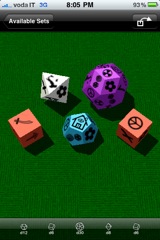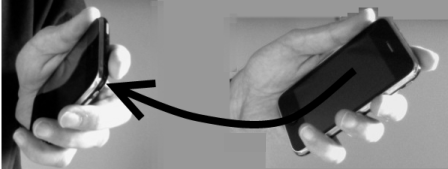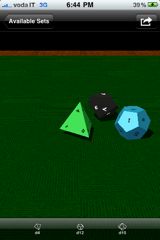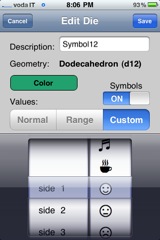Handcrafted software since 1984
![]()

Current Dice Studio release adds exciting functionalities to the application. In addition to
iOS 4 compatibility and retina display exploitation, even "old" devices can enjoy a smoother graphic,
thanks to OpenGL multisampling.
And don't forget the capability, available since 1.1, for quickly and easily insert of custom symbols
on every dice side, selected from a palette of 100 graphics icons. For example, you could create a 6-sided
dice with meteo symbols that represent the current weather for the day; or you could throw a dice
painted with different weapons, in order to assign which one of them will be used during next battle.

Fig.1a - Some dice using graphic symbols
The standard symbols are useful per se, but you can consider them only as a suggestion: in fact, you are allowed to customize the symbol sheet used in the application. You'll need an external graphic editor, but if you are interested in this, please follow these detailed instructions.
Dice Studio is a utility that allows you to quickly create, assembly and use custom dice;
in a few seconds you select its geometry (number of sides), color, and most important, the
range of values, or the symbols associated with each side, as you like.
Need a 12-sided dice with values from 2 to 24? A 6-sided dice with different smiles representing
your opponent mood? A 30-sided dice
with values from 0 to 90? It's a snap! And if you really, really need to precisely select a
single, specific value for each side, you can do this, too.
As most iPhone app, Dice Studio is easy to learn; basic operations are performed with the usual
conventions. Nevertheless, there are some functions that could be overlooked, or are better
understood with a little explanations.
Refer to next sections for details.
There are two ways to make your dice roll: you can simply tap the button in
the top navigation area, or you can naturally move the device and look
at your results.
The first technique exploit the iPhone/iPod
accelerometer, monitoring its orientation: keep it straight, and the
dice will jump towards you, incline it to left, and dice will go
accordingly.
The second technique make a different use of
accelerometer data, implementing a custom algorithm to detect the
throw: you are free to use the gesture that better suite your style,
but the standard gesture should act as if the dice were laid on the
device as on your hand, as in following figure: you can throw them with
a gentle swipe of the arm.

Fig.1b - How to effectively throw dice
If you look at a 4-sided dice, you see that it doesn't stop with a face
pointing up, but with a vertex; as such, from the standard point of
view, it is difficult to understand which value is the outcome of the throw.
To solve this issue, simply swipe vertically with your finger
across the board (after dice stopped), and you'll easy adjust the view
as you need.


Fig.2 - How to check d4 result
When you add a new dice, it has the standard values preselected (1 on side 1, 2 on side 2, etc.). You can customize the values engraved on every face, using the segmented button in the middle of the screen. In addition to standard configuration, you can choose among two modes: range and custom.

Fig.3 - Standard values
Range - you set the minimum and the maximum value you want on your dice. If the range is
superior to the number of faces, the values will be spaced accordingly; on the contrary, if
the values in range are not enough to cover every face, they will be repeated as needed.
Let take as an example a 6-sided dice.
Standard sequence is the usual 1, 2, 3, 4, 5, 6.
If you select a range with minimum = 5, maximum = 20, the resulting sequence will be 5, 8, 11, 14, 17, 20.
If you select a range with minimum = 5, maximum = 8, the resulting sequence will be 5, 6, 7, 8, 5, 6.
This mode is useful when you want to constraint the values of the dice in a quick and effective way.
Some race car simulation game use this technique to constrain the high-gear dice to a range
in the upper values; for example, Formula D (formerly Formula Dé) sixth gear is a 30-sided
dice with values that are equally distributed between 21 and 30 (thus effectively repeating
each value on three faces).
In other games, like role-playing games and miniature wargames that used percentile-based
skills, usually you'll define a 10-sided dice for the tens, assigning a min-max range 0-90;
the standard d10 sequence is 0-9, and it can be used for the units dice.

Fig.4 - How to set an ordered range of values
Custom - in this mode you have maximum flexibility in the definition of the values for
each side. The picker allows you to associate to each side any number in the range 0-99,
thus obtaining a truly custom setup; simply select the side you want to modify in the left
dial, then move the right dial to set the numeric value.
If you activate the "Symbols" switch, you'll associate a special graphic to each side.
Usually you'll apply this mode to low-sided dice, as it can be tedious to define 20 or 30 values one by one.
But there is a little trick: if you want to associate a contiguous set of symbols, first set them as numeric Range, save the dice,
then simply switch the symbols on: the range is translated to the correspondent symbols.


Fig.5 - How to set custom values and symbols